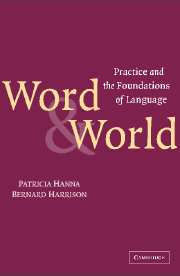10 - Truth and Use
Published online by Cambridge University Press: 05 June 2012
Summary
Negative description
In Chapter 9, we presented some intuitive objections to a very widespread and popular account of the extent and nature of the observational basis available to ground judgments of meaning. Our business in this chapter is to explain the basis of the intuitions involved, in the process clarifying their relationships to one another and revealing the reasoning underlying what was in Chapter 9 no more than an intuitively founded scepticism.
A good place to start is the following – as usual extraordinarily condensed and so superficially gnomic – string of remarks from §82 of Wittgenstein's Philosophical Remarks.
“I haven't got stomach-ache” may be compared to the proposition “These apples cost nothing.” The point is that they don't cost any money, not that they don't cost any snow or any trouble. The zero is the zero point of one scale. And since I can't be given any point on the yardstick without being given the yardstick, I can't be given its zero point either. “I haven't got a pain” doesn't refer to a condition in which there can be no talk of pain, on the contrary we're talking about pain. The proposition presupposes the capacity for feeling pain, and this can't be a “physiological capacity” – for otherwise how would we know what it was a capacity for – it's a logical possibility. – I describe my present state by alluding to something that isn't the case. If this allusion is needed for the description (and isn't merely an ornament), there must be something in my present state making it necessary to mention (allude to) this. […]
- Type
- Chapter
- Information
- Word and WorldPractice and the Foundations of Language, pp. 207 - 230Publisher: Cambridge University PressPrint publication year: 2003



